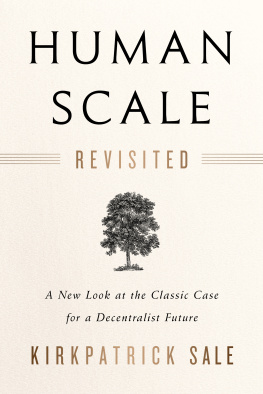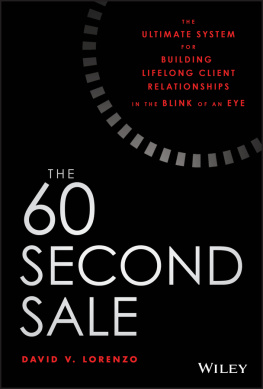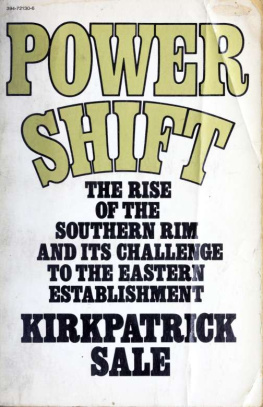Praise for Human Scale Revisited
Like Schumachers Small Is Beautiful but packed with countless examples and careful theory on how to create a truly democratic community from the bottom up, Sales charming update of his classic Human Scale is the best single book on how to build a localist world. A must read!
Gar Alperovitz , author of What Then Must We Do? ; cofounder, The Democracy Collaborative
Human Scale was once ahead of its time, but this updated edition is just in time. While the mainstream assumes that the worldwide grassroots repudiation of globalization will mean war, racism, and poverty, Kirkpatrick Sales classic book shows how true localization can lay the foundation for peace, harmony, and prosperity. This is indispensable reading for anyone who cares about replacing Big Brother with small-scale democracy.
Michael H. Shuman , author of The Local Economy Solution
Is it possible to improve a classic? Kirkpatrick Sale has done so with this erudite, provocative, and, ultimately, hopeful exploration of human-scale alternatives to soul-deadening Bigness in agriculture, architecture, business, education, government.... You name it, Sale knows it.
Bill Kauffman , author of Bye-Bye, Miss American Empire and Dispatches from the Muckdog Gazette
Also by Kirkpatrick Sale
The Land and People of Ghana (1963, 1972)
SDS (1973)
Power Shift: The Rise of the Southern Rim and Its Challenge to the Eastern Establishment (1975)
Dwellers in the Land: The Bioregional Vision (1985)
The Conquest of Paradise: Christopher Columbus and the Columbian Legacy ( 1990)
The Green Revolution: The American Environmental Movement, 19621992 (1993)
Rebels Against the Future: The Luddites and Their War on the Industrial Revolution (1995)
The Fire of His Genius: Robert Fulton and the American Dream (2001)
Why the Sea Is Salt: Poems of Love and Loss (2001)
After Eden: The Evolution of Human Domination ( 2006)
Emancipation Hell: The Tragedy Wrought by the Emancipation Proclamation (2012)
Copyright 2017 by Kirkpatrick Sale.
All rights reserved.
Unless otherwise noted, all illustrations copyright 2017 by Kirkpatrick Sale.
No part of this book may be transmitted or reproduced in any form by any means without permission in writing from the publisher.
This book is an updated and revised edition of a work originally published in 1980 by Coward, McCann & Geoghegan.
The author gratefully acknowledges the following for granting permission to quote from copyrighted materials: Houghton Mifflin Co. for an excerpt from America Was Promises from New & Collected Poems, 19171976 by Archibald MacLeish, by permission of Houghton Mifflin Co., copyright 1976 by Archibald MacLeish; Rutgers University Press for an excerpt from The Size of Song by John Ciardi from Person to Person , by permission of Rutgers University Press, 1964 by Rutgers The State University of New Jersey.
Project Manager: Patricia Stone
Project Editor: Joni Praded
Copy Editor: Polly Zetterberg
Indexer: Shana Milkie
Designer: Melissa Jacobson
Printed in the United States of America.
First printing April 2017.
10 9 8 7 6 5 4 3 2 117 18 19 20 21
Our Commitment to Green Publishing
Chelsea Green sees publishing as a tool for cultural change and ecological stewardship. We strive to align our book manufacturing practices with our editorial mission and to reduce the impact of our business enterprise in the environment. We print our books and catalogs on chlorine-free recycled paper, using vegetable-based inks whenever possible. This book may cost slightly more because it was printed on paper that contains recycled fiber, and we hope youll agree that its worth it. Chelsea Green is a member of the Green Press Initiative ( www.greenpressinitiative.org ), a nonprofit coalition of publishers, manufacturers, and authors working to protect the worlds endangered forests and conserve natural resources. Human Scale Revisited was printed on paper supplied by McNaughton & Gunn that contains 100% postconsumer recycled fiber.
Library of Congress Cataloging-in-Publication Data is available upon request.
Chelsea Green Publishing
85 North Main Street, Suite 120
White River Junction, VT 05001
(802) 295-6300
www.chelseagreen.com
Dedicated to Leopold Kohr,
19091994
great man, good friend
CONTENTS
PART ONE
TOWARD THE HUMAN SCALE
Units of measure are the first condition of all. The builder takes as his measure what is easiest and most constant: his pace, his foot, his elbow, his finger. He has created a unit which regulates the whole work.... It is in harmony with him. That is the main point.
Le Corbusier , Towards a New Architecture , 1958
The proper size of a bedroom has not changed in thousands of years. Neither has the proper size of a door nor the proper size of a community....
Scale: by that we mean that buildings and their components are related harmoniously to each other and to human beings. In urban design we also mean that a city and its parts are interrelated and also related to people and their abilities to comprehend their surroundings.
Paul D. Spreiregen , Urban Design: The Architecture of Towns and Cities , 1965
The most important balance of all the elements in space is that of the human scale.
Constantine Doxiadis , Ekistiks , 1968
Parthenothanatos
For more than two thousand years the Parthenon has stood atop the Acropolis, an enduring monument to the imagination and craft of humankind and to the complex civilization that gave it birth.
Artfully placed against the backdrop of two dramatic mountains, on a large stone outcrop 500 feet above the Aegeans Saronic Gulf, it was purposefully built at an angle to the entrance gate so that you see it first not head on but in perspective, the columns receding in order and harmony, their delicately fluted lines etching a series of shadows in the Attic light against the bright, creamy stone. As you approach, the temple seems almost to float, massive and assertive though it is, for it rests on a slight hill and it was crafted without any true verticals whatsoever, the columns bending inward from base to capital with infinite subtlety and precision, the flutes so carefully measured that each one had to be carved individually like a jewel, the whole effect pulling the eye imperceptibly upward. It asserts, directly though not stridently, the glory that was Greece, or more properly, Athens.
Close up, the human measure is pronounced in the buildings decorations and relationships. The exterior sculptures, at least in original form, though many have decayed, display an extraordinary concern for the varieties of the human form, in motion and at rest, clothed and naked, while the friezes of the Panathenaic procession convey the energy and centrality of the workaday civic life of the city below. Within, the sense of the human measure is again reflected in the dimensions of the columns and remnant forms, and the rational, humanistic spirit that originally informed it is unmistakable still.
Indeed, for all its outsized grandeur and magnitude, it is a building carefully gracefully designed on the human scale, measured by the human thumb and pace and body, created in its every detail with the principle, to be articulated by Protagoras only a few decades later, of man the measure of all things. The height of the average ancient Greek man, known to be shorter than a modern European, I have calculated to be about 5 feet 7 inches, a figure confirmed by the fact that, allowing for minuscule variations in the original construction and in the settlement of the building over the years, it is in exact multiples of this measure to which the major dimensions were built. The full height is 540.12 inches, that unit by 8, the width is 1,215.3 inches, that unit by 18, and the length is 2,734.3 inches, that unit by 40.5. The interior columns at 202.5 inches reflect that unit by 3, the distance between the architraves is 405 inches, that unit by 6, and the statue of Athena herself, the goddess to whom the city and temple were consecrated, may have been around 12 meters, or 473 inches tall, exactly 7 times that unit. It is a monument to the human scale, only natural in a land whose cities were ordered according to the human scale, whose society, economic relations, and government were all constructed with regard to the human scale.




















